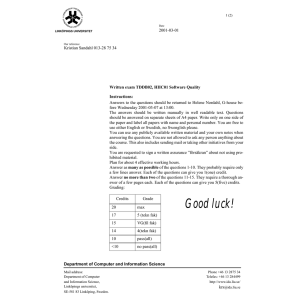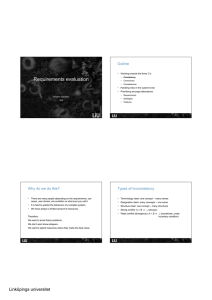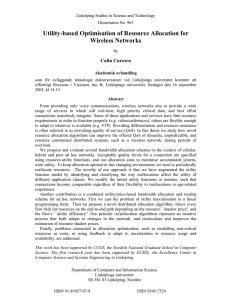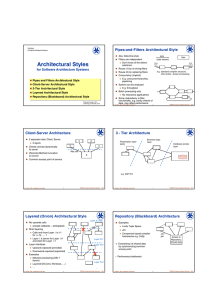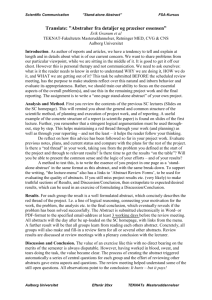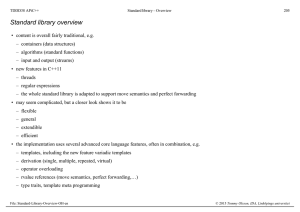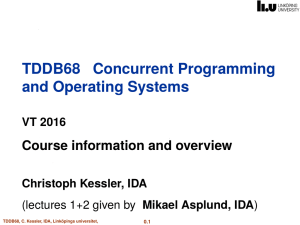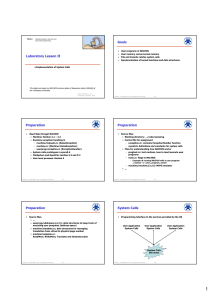Agenda Laboratory Lesson I
advertisement
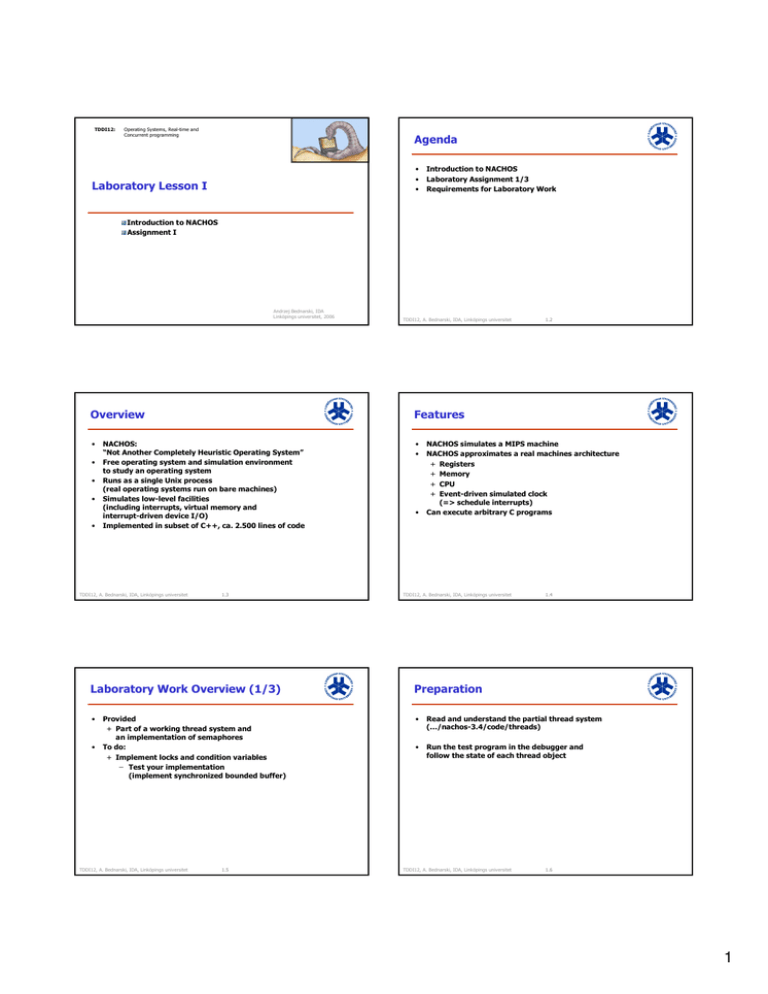
TDDI12:
Operating Systems, Real-time and
Concurrent programming
Agenda
•
•
•
Laboratory Lesson I
Introduction to NACHOS
Laboratory Assignment 1/3
Requirements for Laboratory Work
Introduction to NACHOS
Assignment I
Andrzej Bednarski, IDA
Linköpings universitet, 2006
Overview
•
•
•
•
•
1.3
Laboratory Work Overview (1/3)
•
•
Provided
+ Part of a working thread system and
an implementation of semaphores
To do:
+ Implement locks and condition variables
̶ Test your implementation
(implement synchronized bounded buffer)
TDDI12, A. Bednarski, IDA, Linköpings universitet
1.2
Features
NACHOS:
“Not Another Completely Heuristic Operating System”
Free operating system and simulation environment
to study an operating system
Runs as a single Unix process
(real operating systems run on bare machines)
Simulates low-level facilities
(including interrupts, virtual memory and
interrupt-driven device I/O)
Implemented in subset of C++, ca. 2.500 lines of code
TDDI12, A. Bednarski, IDA, Linköpings universitet
TDDI12, A. Bednarski, IDA, Linköpings universitet
1.5
•
•
•
NACHOS simulates a MIPS machine
NACHOS approximates a real machines architecture
+ Registers
+ Memory
+ CPU
+ Event-driven simulated clock
(=> schedule interrupts)
Can execute arbitrary C programs
TDDI12, A. Bednarski, IDA, Linköpings universitet
1.4
Preparation
•
Read and understand the partial thread system
(…/nachos-3.4/code/threads)
•
Run the test program in the debugger and
follow the state of each thread object
TDDI12, A. Bednarski, IDA, Linköpings universitet
1.6
1
(NACHOS) Threads
•
•
(NACHOS) Threads
Thread Object methods:
+ Thread
+ Fork
+ StackAllocate
+ Yield
+ Sleep
+ Finish
Read documentation / source code
TDDI12, A. Bednarski, IDA, Linköpings universitet
1.7
Semaphore
•
•
NACHOS Threads’ status:
+ READY
+ RUNNING
+ BLOCKED
+ JUST_CREATED (temporary state)
•
The scheduler decides which thread to run next
•
Synchronization facilities provided through semaphores
TDDI12, A. Bednarski, IDA, Linköpings universitet
P() or Wait()
A semaphore is an integer variable,
accessible only by the operations
Wait and Signal (Originally called P and V)
•
Signal(S): S := S + 1;
1.9
V() or Signal()
•
TDDI12, A. Bednarski, IDA, Linköpings universitet
1.10
Overview
Increment the semaphore’s count,
release one thread if any are blocked waiting on the count
void Semaphore::V() {
Thread *thread;
IntStatus oldLevel = interrupt->SetLevel(IntOff);
thread = (Thread *)queue->remove();
if (thread != NULL)
scheduler->ReadyToRun(thread);
value = value + 1;
(void) interrupt->SetLevel(oldLevel);
}
TDDI12, A. Bednarski, IDA, Linköpings universitet
Decrement the semaphore’s count,
block the caller if count is less than zero or zero
void Semaphore::P() {
IntStatus oldLevel = interrupt->SetLevel(IntOff);
while(value <= 0) {
queue->Append((void *)currentThread);
currentThread->Sleep();
}
value = value - 1;
(void) interrupt->SetLevel(oldLevel);
}
Wait(S): while S <= 0 do no-op;
S := S -1;
TDDI12, A. Bednarski, IDA, Linköpings universitet
1.8
1.11
•
Implement locks and conditions - when used together provides
the same functionality as monitors
•
Write code for the Lock and Condition classes
(in the file .../code/threads/sync.cc)
+ Interfaces (class definition) for Lock and Condition are already
defined (in .../code/threads/sync.h)
+ No changes to the interfaces should be done. Only needed
variables should be added to the classes
+ NB: It should not take too much code for you to implement all
functionality
TDDI12, A. Bednarski, IDA, Linköpings universitet
1.12
2
Lock
•
Condition Variables
Binary semaphore (with constraints)
•
class Lock {
public:
Lock(char* debugName);
~Lock();
void Acquire(); // atomic
void Release(); // atomic
bool isHeldbyCurrentThread();
private:
char *name;
// some variables you need
};
P1
•
TDDI12, A. Bednarski, IDA, Linköpings universitet
1.13
Condition Variable (Wait)
•
•
•
•
Release the Lock
Add the thread to waiting thread on this condition
Release the CPU (sleep)
Acquire the Lock (after wake-up)
TDDI12, A. Bednarski, IDA, Linköpings universitet
1.15
Test Your Implementation
•
•
•
Write a class BoundedBuffer and use it for Producer / Consumer
communication (see [SGG 7, Sec. 6.6])
Check border conditions
Try with several Producers / Consumers (see course homepage)
1.17
P2
P3
Lock1->Acquire()
Lock3->Acquire()
Lock2->Acquire()
Lock2->Acquire()
Lock1->Acquire()
Lock3->Acquire()
…
…
…
Lock2->Release()
Lock1->Release()
Lock3->Release()
Lock1->Release()
Lock3->Release()
Lock2->Release()
While hold a lock if cannot use it?
TDDI12, A. Bednarski, IDA, Linköpings universitet
1.14
Condition Variable (Signal)
•
•
Take one thread from the queue
Run it (scheduler->ReadyToRun(thread))
TDDI12, A. Bednarski, IDA, Linköpings universitet
1.16
Laboratory Sessions
•
Mark your changes in the source code
//
//
//
//
//
•
•
TDDI12, A. Bednarski, IDA, Linköpings universitet
Semaphores and Locks are inefficient when dealing with
multiple resources
-------------------------------------------------02-04-24: your name: changes
...
end of changes
--------------------------------------------------
Show working solutions
Turn in hard copy of your changed code
+ testprogram
+ documentation
TDDI12, A. Bednarski, IDA, Linköpings universitet
1.18
3
Laboratory Sessions (cont’)
•
Documentation
+ A readme file which contain:
̶ The files you have created and a short description
̶ The major changes you have made to the given files
+ Testcase file(s)
̶ Which test cases did you use
̶ What was the output of the test cases
̶ What those testcases should demonstrate
TDDI12, A. Bednarski, IDA, Linköpings universitet
1.19
4
